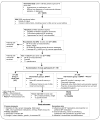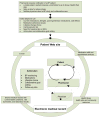Electronic communications and home blood pressure monitoring (e-BP) study: design, delivery, and evaluation framework
- PMID: 17974502
- PMCID: PMC2645352
- DOI: 10.1016/j.cct.2007.09.005
Electronic communications and home blood pressure monitoring (e-BP) study: design, delivery, and evaluation framework
Abstract
Background: Randomized controlled trials have provided unequivocal evidence that treatment of hypertension decreases mortality and major disability from cardiovascular disease; however, blood pressure remains inadequately treated in most affected individuals. This large gap continues despite the facts that more than 90% of adults with hypertension have health insurance, and hypertension is the leading cause of visits to the doctor. New approaches are needed to improve hypertension care.
Objectives: The Electronic Communications and Home Blood Pressure Monitoring (e-BP) study is a three-arm randomized controlled trial designed to determine whether care based on the Chronic Care Model and delivered over the Internet improves hypertension care. The primary study outcomes are systolic, diastolic, and blood pressure control; secondary outcomes are medication adherence, patient self-efficacy, satisfaction and quality of life, and healthcare utilization and costs.
Methods: Hypertensive patients receiving care at Group Health medical centers are eligible if they have uncontrolled blood pressure on two screening visits and access to the Web and an e-mail address. Study participants are randomly assigned to three intervention groups: (a) usual care; (b) home blood pressure monitoring receipt and proficiency training on its use and the Group Health secure patient website (with secure e-mail access to their healthcare provider, access to a shared medical record, prescription refill and other services); or (c) this plus pharmacist care management (collaborative care management between the patient, the pharmacist, and the patient's physician via a secure patient website and the electronic medical record).
Conclusion: We will determine whether a new model of patient-centered care that leverages Web communications, self-monitoring, and collaborative care management improves hypertension control. If this model proves successful and cost-effective, similar interventions could be used to improve the care of large numbers of patients with uncontrolled hypertension.
Figures




References
-
- Kearney PM, Whelton M, Reynolds K, et al. Global burden of hypertension: analysis of worldwide data. Lancet. 2005 Jan 15-2005 Jan 21;365(9455):217–23. - PubMed
-
- Fields LE, Burt VL, Cutler JA, et al. The burden of adult hypertension in the United States 1999 to 2000: a rising tide. Hypertension. 2004 Oct;44(4):398–404. - PubMed
-
- The Sixth Report of the Joint National Committee on Prevention, Detection, Evaluation, and Treatment of High Blood Pressure. Arch Intern Med. 1997;157:2413–46. - PubMed
-
- Wang TJ, Vasan RS. Epidemiology of uncontrolled hypertension in the United States. Circulation. 2005 Sep 13;112(11):1651–62. - PubMed
-
- Lloyd-Jones DM, Evans JC, Levy D. Hypertension in adults across the age spectrum: current outcomes and control in the community. JAMA. 2005 Jul 27;294(4):466–72. - PubMed
Publication types
MeSH terms
Substances
Grants and funding
LinkOut - more resources
Full Text Sources
Medical
Miscellaneous

